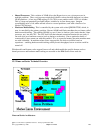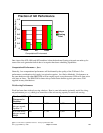
Here, a model 840 was subdivided into the partition sizes shown and a typical web serving load was used.
A "hit" is one web page or one image. The kttpd is a kernel-based daemon available on Linux which
serves only static web pages or images. It can be cascaded with ordinary Apache to provide dynamic
content as well. The other is a standard Apache 1.3 installation. The 820 or 830 would be a bit less, by
about 10 per cent, than the above numbers.
Network Operations
Here's some results using Virtual and 100 megabit ethernet. This pattern was repeated in several
workloads using 820 and 840 processors:
1100-9500 connections per
second
200-3000 connections per
second
Make Connections
200-400 megabits per second50-90 megabits per secondTransmit Data
Virtual LAN100 megabit Ethernet LANTCP/IP Function
The 825, 870, and 890 should produce slightly higher virtual data rates and nearly the same 100 megabit
ethernet rates (since the latter is ultimately limited by hardware). The very high variance in the "make
connections" relates, in part, to the fact that several workloads with different complexities were involved.
We also have more limited measurements on Gigabit ethernet showing about 450 megabits per second for
some forms of data transmission. For planning purposes, a rough parity between gigabit and Virtual LAN
should be assumed.
Gcc and High Optimization (gcc compiler option -O3)
The current gcc compiler is used for a great fraction of Linux applications and the Linux kernel. At this
writing, the current gcc version is ordinarily 2.95, but this will change over time. This section applies
regardless of the gcc version used. Note also that some things that appear to be different compilers (e.g.
g++) are front-ends for other languages (e.g. C++) but use gcc for actual generation of code.
Generally speaking, RISC architectures have assumed that the final, production version of an application
would be deployed at a high optimization. Therefore, it is important to specify the best optimization level
(gcc option -O3) when compiling with gcc or any gcc derivatives. When debugging (-g), optimization is
less important and even counterproductive, but for final distribution, optimization often has dramatic
performance differences from the base case where optimization isn’t specified.
Programs can run twice as fast or even faster at high versus low optimization. It may be worthwhile to
check and adjust Makefiles for performance critical, open source products. Likewise, if compilers other
than gcc are deployed, they should be examined to see if their best optimizations are used.
One should check the man page (man gcc at a command line) to see if other optimizations are warranted.
Some potentially useful optimizations are not automatically turned on because not all applications may
safely use them.
The Gcc Compiler, Version 3
IBM i 6.1 Performance Capabilities Reference - January/April/October 2008
© Copyright IBM Corp. 2008 Chapter 13 - Linux 183


















